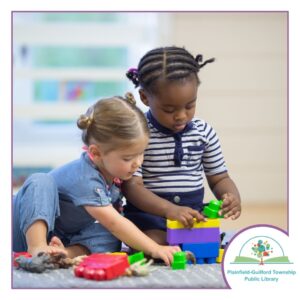30 Oct Ready to Read: Play
 “Play is the work of childhood,” asserts child psychologist Jean Piaget.
“Play is the work of childhood,” asserts child psychologist Jean Piaget.
It may be tempting for adults to discourage free play and instead guide children to more structured educational activities like counting or letter recognition. But for children, playing is serious business.
The importance of play
During play, children exercise creativity, practice vocabulary, conduct science experiments, and try on different roles. In doing so, they are strengthening both their fine and gross motor skills, learning about the world and how it works, and expanding their overall knowledge. Young children learn new things every minute of every day, and playing helps integrate all of that new information.
And when we think about school readiness, the more a child understands the world, the more context they will have to help them understand what they are reading.
Playing is so essential to children’s development and pre-literacy work that we incorporate it into every single one of our library storytimes. It’s one of the five essential practices highlighted in the Every Child Ready to Read initiative, right alongside reading, talking, writing, and singing.
Thankfully, play is also the easiest practice to incorporate at home. Children are naturally drawn to explore their world, try things out, and – eventually – play!
Parents and caregivers can support this natural inclination by providing open-ended materials and safe spaces in which children can explore, play, and learn with minimal interference.
Tips to encourage play at home
For babies, a simple “treasure basket” of baby-safe household items of different sizes, weights, and textures provides a lot of fascination. For toddlers, things like wooden blocks, magnetic tiles, and push/pull toys are excellent choices. As children get older, their play becomes more imaginative, and things like pretend food, dress-up clothes, and dolls start to pique their interest. The library even has many of these types of toys available to play with at the library or to check out from our J Library of Things.
Allow your child to play with the item(s) however they see fit, as long as they aren’t doing anything that would damage them. If they are very focused, it’s best to let them be and not interrupt their concentration.
Become a close observer of their work. Notice what catches their attention. Do they keep doing something over and over? Are they experimenting with the toy in some way? Children are natural explorers and scientists, and free play allows them to nurture their curiosity. See if you can figure out what they are learning as they play on their own.
Engaging with play
If your child seems open to engagement while they play, ask open-ended questions. “What is happening here?” “What are you making?” “What do you notice?” “What happens when you … ?” Be sure to give your child plenty of time to answer — at least five full seconds.
You can also narrate what they are doing: “You built a tall tower and then knocked it over!”
Resist the urge to direct your child’s play, however. Simply add conversation to it by showing interest in what they’re doing; this builds vocabulary and helps them connect learning to play!
The simple act of allowing your child to play is a great way to help them be ready to read!
Written by Carolyn L., Youth Services Library Assistant



